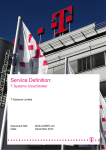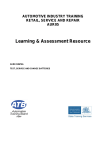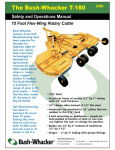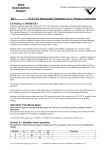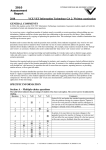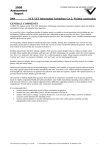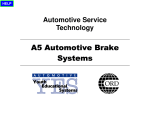Download Apply basic automotive troubleshooting processes
Transcript
Training Package Automotive Industry Retail, Service and Repair (AUR05) Unit title Apply basic automotive troubleshooting processes Unit code HSC Requirements and Advice Unit descriptor AURC252103A HSC Indicative Hours This unit covers the competence to conduct troubleshooting functions required to identify common automotive faults or problems based on evidence provided by customers. Evidence Guide The evidence guide identifies critical aspects, knowledge and skills to be demonstrated to confirm competence for this unit. This is an integral part of the assessment of competence and should be read in conjunction with the Range Statement. Critical aspects of evidence Underpinning knowledge It is essential that competence is fully observed and there is ability to transfer competence to changing circumstances and to respond to unusual situations in the critical aspects of: • using questioning, listening and observation skills to determine the nature of customer enquiries • identifying automotive systems and components • consistently applying basic troubleshooting techniques to determine possible causes of faults or problems • communicating effectively with others involved in or affected by the work. Automotive Curriculum Framework • General knowledge of the range of enterprise merchandise and services, location of departments/sections and telephone extensions of departments/sections. • General operational knowledge of industry/workplace codes of practice in relation to customer service. • General operational knowledge of the function of major components of common automotive: - engine systems - transmissions and drive trains - steering and suspension systems - fuel systems - cooling systems - electrical systems - braking systems - exhaust systems. • General operational knowledge of basic troubleshooting techniques/processes. September 2007 20 HSC Requirements and Advice Key Terms and Concepts • automotive system/component • basic troubleshooting techniques/ processes • causes of common faults/problems • codes of practice • customer contact • customer expectations • customer service • customer types • departments/sections • diagnostic charts • key personnel • merchandise and services • methods of approaching a customer • performance analysis/testing • questioning, listening and observation skills • quotations/estimates of repairs • specialist areas • vehicle systems • verbal communication • visual inspection. AURC252103A Apply basic automotive troubleshooting processes 25 HSC Requirements and Advice Evidence Guide cont/d Context of assessment The elements of competence contain both knowledge and practical components. The knowledge components may be assessed off the job. The practical components should be assessed on the job or in a simulated work environment covering a range of customer types. Specific resource requirements for this unit Method of assessment It is preferable that assessment reflects a process rather than an event and occurs over a period of time to cover varying circumstances. Evidence of performance may be provided by customers, team leaders/members or other persons subject to agreed authentication arrangements. The following should be made available: • a workplace or simulated workplace • enterprise or equivalent policy and procedures relating to customer service • a range of customers with enquiries. This unit may be assessed in conjunction with other units that form part of the job role or function. Automotive Curriculum Framework September 2007 AURC252103A Apply basic automotive troubleshooting processes 26 Specific key competencies, underpinning and employability skills required to achieve the performance criteria These include a number of processes learned throughout work and life, which are required in most jobs. Some of these are covered by the national key competencies, although others may be added. The details below highlight how these competencies are applied in the attainment of this unit. Application of the key competencies in this unit are to satisfy the nominated level in which: Level 1 – relates to working effectively within set conditions and processes; Level 2 – relates to management or facilitation of conditions or processes; and Level 3 – relates to design, development and evaluation of conditions or process. How will the candidate apply the following key competency in this unit? The candidate will need to: Collect, analyse and organise information Collect, organise and understand information related to technical literacy and interpretive skills to interpret and discern facts related to a customer enquiry. Level 1 Communicate ideas and information Questioning and active listening skills, e.g. when obtaining factual information from customers. Plain English literacy and communication skills in relation to dealing with customers. Level 1 Plan and organise activities Collect, organise and understand information related basic automotive troubleshooting. Level 1 Work with others and in a team Work with others and in a team by seeing and conveying information related to the planning, sequencing and completion of the task. Level 1 Use mathematical ideas and techniques Use mathematical ideas and techniques to count and measure. Level 1 Solve problems Establish diagnostic processes which include analytical skills to determine the possible causes of the fault or problem. Level 1 Use technology Use the workplace technology related to basic automotive troubleshooting. Level 1 Automotive Curriculum Framework September 2007 AURC252103A Apply basic automotive troubleshooting processes 27 Element Performance Criteria Range Statement 1 1.1 The Range Statement provides advice to interpret the scope and context of this unit of competence, allowing for differences between enterprises and workplaces. It relates to the unit as a whole and facilitates holistic assessment. The following variables may be present for this particular unit: Identify nature of the fault or problem Customer is made to feel welcome and valued. Unit scope • customers may be regular or new and may have routine or special requests. They may include persons from a range of social, cultural or ethnic backgrounds and physical and intellectual abilities. Customers are made to feel welcome, valued and, at the end of the process, satisfied. Customer contact may be face to face, by telephone, by electronic means or in writing • staff may be full time, part time or casual and vary in terms of training, product knowledge and in staffing levels, e.g. staff shortages. Staff may be operating in routine or busy trading conditions. • enterprises may vary in size, type and location and in the range of merchandise, products and services provided . HSC Requirements and Advice Learning experiences for the HSC must address: An awareness of the type of knowledge employees should be familiar with including: • product/merchandise and service range • location and primary role of departments/sections • telephone extensions of departments/sections • key personnel and their role. NB This unit of competency requires students to develop knowledge in relation to a range of merchandise and services offered by at least one workplace/organisation. Ideally, this could be undertaken during work placement with students reporting their findings and experience to the class on their return. This will ensure students are made aware of a range of automotive environments and the differences in practices between workplaces/organisations. Types of customers including: • new or repeat/regular • individual or business/organisation • external and internal • customers with routine or special needs/requests • people from a range of social, cultural or ethnic backgrounds • people with disabilities. A knowledge of: • workplace/organisation policy and procedures in relation to establishing contact with customers • industry code of practice in relation to quality customer service. Customer contact including: • face-to-face • telephone • electronic means • written. Automotive Curriculum Framework September 2007 AURC252103A Apply basic automotive troubleshooting processes 28 Element Performance Criteria Range Statement HSC Requirements and Advice A knowledge of: • different methods of approaching a customer - greeting - merchandise - service • timing of approaches • opening techniques. Awareness of the importance of effective, positive and efficient customer service. Benefits of good customer service including: • promoting goodwill • client loyalty/repeat business • new business • productivity • credibility • promoting workplace/organisation service ethic. An awareness of factors customers expect in good service including: • individualised attention • price • quality • product knowledge • appropriate presentation • polite and courteous service • efficiency • consistency. Establishing good customer service including: • knowledge of workplace/organisation policies • using language that is targeted to the specific customer • presenting a friendly and courteous manner • using positive gestures and body language • ensuring prompt response to enquiry/request • adopting a solutions-oriented approach • following up to maximise customer satisfaction. Automotive Curriculum Framework September 2007 AURC252103A Apply basic automotive troubleshooting processes 29 Element Performance Criteria 1.2 Range Statement Questioning techniques are applied to determine nature of the customer enquiry. HSC Requirements and Advice Learning experiences for the HSC must address: Effective verbal communication including: • appropriate language • a clear voice • audible volume • a courteous tone • active listening • asking questions or rephrasing to clarify or confirm understanding. Effective questioning techniques including: • open questions • closed questions • reflective questions. Effective communication techniques in relation to listening including: • active listening • barriers to effective listening. Verbal questioning including: • face-to-face • over the telephone. 1.3 Available information relating to the fault or problem is gathered, documented and confirmed with customer. Unit scope • the types of common faults or problems on which advice is required may include basic troubleshooting related to: - failure to achieve ignition/power - failure to achieve fuel flow - failure of lighting systems/components - excessive exhaust smoke or noise - unusual engine noises or vibrations - excessive play or vibration through steering - loss of coolant - slow response or excessive pedal travel when braking. Information • enterprise policies and procedures, equipment and product manufacturer/ Automotive Curriculum Framework September 2007 Learning experiences for the HSC must address: An understanding of vehicle systems and an awareness of the common faults or problems associated with: • starting/ignition • fuel • electrical • engine mechanical • steering • suspension • cooling • braking. Knowledge of basic troubleshooting methods including: • use of customer complaint/information AURC252103A Apply basic automotive troubleshooting processes 30 Element Performance Criteria Range Statement component supplier specifications, enterprise operating procedures, industry/ workplace codes of practice and customer enquiries/requests. Unit context • legislative requirements - include State/Territory legislation related to OH&S and consumer law - may also include industry codes of practice. HSC Requirements and Advice • visual inspection • performance analysis/testing - manual/electronic - audible test - road test/test drive • use of diagnostic charts • use of specialist equipment - data and scan tools - onboard computer diagnostics. An awareness of paper-based and electronic means for recording customer details and their requests/ enquiries. The importance of recording information that is: • clear • legible • accurate • concise • appropriate in terms of industry terminology and abbreviations. 2 Apply basic troubleshooting processes Automotive Curriculum Framework 2.1 Automotive system/component relating to the fault or problem is identified. 2.2 Basic troubleshooting techniques are applied to identify the likely cause of the fault or problem. 2.3 Advice is sought from the enterprise September 2007 Unit scope • automotive systems/components may include: - engine systems - transmissions/drive trains - steering and suspension systems - fuel systems - cooling systems - electrical systems - braking systems - exhaust systems. Learning experiences for the HSC must address: Identification and understanding of the general features, purpose, maintenance and operational knowledge of a range of automotive systems/ components including: • engine systems • transmissions and drive trains • steering and suspension systems • fuel systems • cooling systems • electrical systems • braking systems • exhaust systems. Learning experiences for the HSC must address: AURC252103A Apply basic automotive troubleshooting processes 31 Element Performance Criteria Range Statement product/system specialist. HSC Requirements and Advice Awareness of a range of specialist areas in the automotive industry including: • fuel injection • engine management • auto-electrical • automatic transmission • air-conditioning • brakes • steering and suspension. Knowledge of the scope of responsibility and allocated duties and areas of expertise of other staff in the workplace/organisation. 2.4 Customer is advised of the likely cause and possible solutions to the fault or problem. Unit scope • advice offered to the customer is to conform with statutory and organisationally imposed limitations and liability requirements. Learning experiences for the HSC must address: Effective responses to a range of enquiries and requests. Preparation of quotations/estimates of repairs. 2.5 Automotive Curriculum Framework Customer is advised to seek specialist advice if the fault or problem cannot be determined from the available information or is beyond the capacity of the enterprise to rectify. September 2007 Learning experiences for the HSC must address: Knowledge of the product(s) and service(s) provided in other areas/sections/departments of the workplace/ organisation. AURC252103A Apply basic automotive troubleshooting processes 32









